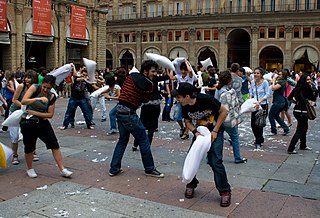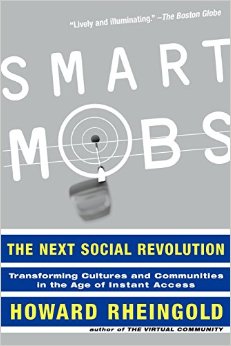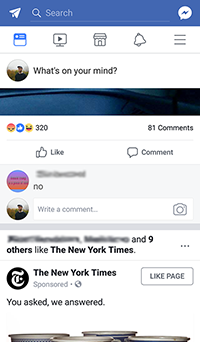
Short Message Service, commonly abbreviated as SMS, is a text messaging service component of most telephone, Internet and mobile device systems. It uses standardized communication protocols that let mobile phones exchange short text messages, typically transmitted over cellular networks.

Instant messaging (IM) technology is a type of synchronous computer-mediated communication involving the immediate (real-time) transmission of messages between two or more parties over the Internet or another computer network. Originally involving simple text message exchanges, modern IM applications and services tend to also feature the exchange of multimedia, emojis, file transfer, VoIP, and video chat capabilities.

A virtual community is a social network of individuals who connect through specific social media, potentially crossing geographical and political boundaries in order to pursue mutual interests or goals. Some of the most pervasive virtual communities are online communities operating under social networking services.
Technological convergence is the tendency for technologies that were originally unrelated to become more closely integrated and even unified as they develop and advance. For example, watches, telephones, television, computers, and social media platforms began as separate and mostly unrelated technologies, but have converged in many ways into an interrelated telecommunication, media, and technology industry.

A flash mob is a group of people that assembles suddenly in a public place, performs for a brief time, then quickly disperses, often for the purposes of entertainment, satire, and/or artistic expression. Flash mobs may be organized via telecommunications, social media, or viral emails.

Text messaging, or simply texting, is the act of composing and sending electronic messages, typically consisting of alphabetic and numeric characters, between two or more users of mobile phones, tablet computers, smartwatches, desktops/laptops, or another type of compatible computer. Text messages may be sent over a cellular network or may also be sent via satellite or Internet connection.

Howard Rheingold is an American critic, writer, and teacher, known for his specialties on the cultural, social and political implications of modern communication media such as the Internet, mobile telephony and virtual communities.
A guerrilla gig is a type of concert performed in a non-traditional setting or arranged in an unusual fashion. It became associated with punk rock, and noise rock bands in UK and the United States during the early to mid-2000s. Bands who perform at such events are sometimes referred to as "guerrilla rockers".

A pillow fight flash mob is a social phenomenon of flash mobbing and shares many characteristics of a culture jam.

Smart Mobs: The Next Social Revolution is a book by Howard Rheingold dealing with the social, economic and political changes implicated by developing technology. The book covers subjects from text-messaging culture to wireless Internet developments to the impact of the web on the marketplace. The author highlights the many ways in which technology alters and impacts the way in which people live and think.
Hardbass or hard bass is a subgenre of pumping house that originated in Saint Petersburg, Russia during the late 1990s, drawing inspiration from bouncy techno, hardstyle, as well as local Russian influences. Hardbass is characterized by its fast tempo, donks, distinctive basslines, distorted sounds, heavy kicks and occasional chants or rapping. In several European countries, so-called "hardbass scenes" have sprung up, which are events related to the genre that involve multiple people dancing in public while masked, sometimes with moshing involved.

Mylo, standing for "My Life Online", is a pocket-sized handheld device created and marketed by Sony for instant messaging and other Internet-based communications like browsing Internet web sites using the Opera web browser, and playback and sharing of media files. Debuting in 2006, Mylo had a screen which slid up to reveal a QWERTY keyboard. Using Wi-Fi instead of cellular networks — reducing connectivity costs by avoiding the necessity of using GSM, CDMA or 3G cellular networks which would usually be used for devices of this size and functionality — the Mylo was targeted to the 18–24 age group. A revised model was released in 2008.

Mobile social networking is social networking where individuals with similar interests converse and connect with one another through their mobile phone and/or tablet. Much like web-based social networking, mobile social networking occurs in virtual communities.
Participatory culture, an opposing concept to consumer culture, is a culture in which private individuals do not act as consumers only, but also as contributors or producers (prosumers). The term is most often applied to the production or creation of some type of published media.
Cell phone novels, or mobile phone novels, were literary works originally written on a cellular phone via text messaging. This type of literature originated in Japan, where it became a popular literary genre. However, its popularity also spread to other countries internationally, especially to China, United States, Germany, Italy and South Africa. Chapters usually consist of about 70–100 words each due to character limitations on cell phones.

Short Message Service (SMS) language, textism, or textese is the abbreviated language and slang commonly used in the late 1990s and early 2000s with mobile phone text messaging, and occasionally through Internet-based communication such as email and instant messaging.

A mobile phone, or cell phone, is a portable telephone that allows users to make and receive calls over a radio frequency link while moving within a designated telephone service area, unlike fixed-location phones. This radio frequency link connects to the switching systems of a mobile phone operator, providing access to the public switched telephone network (PSTN). Modern mobile telephony relies on a cellular network architecture, which is why mobile phones are often referred to as 'cell phones' in North America.
Crowd manipulation is the intentional or unwitting use of techniques based on the principles of crowd psychology to engage, control, or influence the desires of a crowd in order to direct its behavior toward a specific action. This practice is common to religion, politics and business and can facilitate the approval or disapproval or indifference to a person, policy, or product. The ethicality of crowd manipulation is commonly questioned.

Art Cluster, in global contemporary art scene, refers a group of artists that work through Internet to promote the free culture and many artistic values. The emerging telecommunications have developed a new form of communication, much faster and more direct. This allows people to work from anywhere in the world. People can easily group or perform any type of organization. Art Cluster also refers artistic production of collective intelligence. The integration of social movement in the cyberspace is one of the potential strategies of this social movement.
Smartphone ad hoc networks are wireless ad hoc networks that use smartphones. Once embedded with ad hoc networking technology, a group of smartphones in close proximity can together create an ad hoc network. Smart phone ad hoc networks use the existing hardware in commercially available smartphones to create peer-to-peer networks without relying on cellular carrier networks, wireless access points, or traditional network infrastructure. Wi-Fi SPANs use the mechanism behind Wi-Fi ad-hoc mode, which allows phones to talk directly among each other, through a transparent neighbor and route discovery mechanism. SPANs differ from traditional hub and spoke networks, such as Wi-Fi Direct, in that they support multi-hop routing and relays and there is no notion of a group leader, so peers can join and leave at will without destroying the network.












